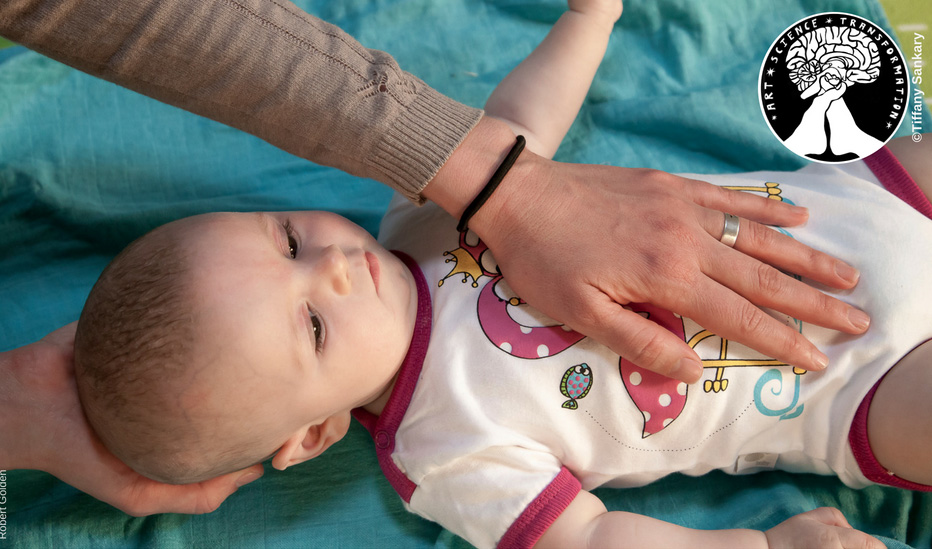by: Carla Oswald Reed, PT, GCFP
What do the children with special needs who receive Feldenkrais® lessons do for the rest of their day, week, month, and year? How much of a difference does it make when their parents are helped to be their children’s primary agents of change? How can children with special needs experience what their peers experience so that they can gradually learn what their peers learn so quickly and effortlessly? How are children with special needs different from their peers anyway?
What’s come to the foreground for me in answering that last question is the lack of variety in the spontaneously generated movements of a child with special needs. Feldenkrais practitioners see children with a huge range of special needs that can differ widely one from another. But all of them have a difference in their brains, physical structure, or early experiences that have interfered with their ability to generate as many variations in their movement as their typical peers.
Sometimes their brains are damaged, or their genetic blueprint is different so that they don’t generate the same range of random or reflexive movements as their peers. Sometimes they were born so prematurely or had some other medical complications or structural anomalies that necessitated an extended period of immobility for lifesaving or reconstructive interventions. All of these conditions result in a child whose brain is structuring itself with a more limited experience of moving in the field of gravity, of perceiving their own body parts, and their interrelationships, and of discovering that they can be competent and confident and have a vital contributing role in their families and in their communities.
The Feldenkrais Method® is a fabulous contribution to these children by introducing the experience of effective movement variations they have not generated for themselves. Yet, over the years, I’ve seen children with cerebral palsy or other developmental challenges who stalled in their learning or developed hip subluxation or dislocation even though the children were having Feldenkrais lessons. Each time I encountered that, I asked myself: what more can Feldenkrais practitioners do? That question led me to ponder how much of a difference it might make if practitioners successfully enlisted their parents as their primary agents of change. Could the value of our lessons be multiplied exponentially?
Fortunately, I had decades of education and experience to bring to my inquiry. After becoming a licensed physical therapist in 1969, I studied with the Bobaths* and learned their NeuroDevelopmental Treatment (NDT) approach to cerebral palsy. I attended the Amherst Feldenkrais Professional Training Program in the eighties and went on to study the pioneering work of Magda Gerber at Resources for Infant Educaring, and the Anat Baniel Method.
As I evolved in my own work, I introduced more movement variations and movement challenges into my clients’ lessons and began guiding parents to help their babies experience more of the movement variations their children were not generating for themselves. For parents, it is important to understand what a difference it can make for their children’s learning when their caregivers pick them up, put them down, and carry them while providing an experience of balancing the weight of the head and pelvis in space effectively.
Parents can also help their children by choosing baby carriers that help manage the weight of their children while at the same time contributing to their children’s learning. Tailoring their toy choices and environmental conditions to make it necessary for their children to use more variations of movement, including introducing deliberate obstacles or playing with their children on the stairs, are other ways parents can assist their children. The changes in the children I worked with were profound and awe-inspiring.
Now, after almost fifty years of work with special needs children, I can confidently say that all children can have an endlessly expanding learning curve when they and their parents have the necessary education, guidance, and support Feldenkrais practitioners are uniquely positioned to offer.
 With a background of almost 50 years as a pediatric Physical Therapist, Carla Oswald Reed practices as a certified Feldenkrais Practitioner and Anat Baniel Method of NeuroMovement Practitioner and Trainer. She has studied with Magda Gerber of Resources for Infant Educarers and with the Bobaths for the NeuroDevelopmental Treatment approach for cerebral palsy. Carla is mother to 4 and grandmother to 7.
With a background of almost 50 years as a pediatric Physical Therapist, Carla Oswald Reed practices as a certified Feldenkrais Practitioner and Anat Baniel Method of NeuroMovement Practitioner and Trainer. She has studied with Magda Gerber of Resources for Infant Educarers and with the Bobaths for the NeuroDevelopmental Treatment approach for cerebral palsy. Carla is mother to 4 and grandmother to 7.
Movementtowholeness.com

